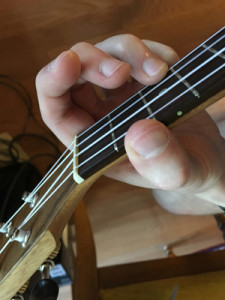Proper Left Hand Form
Left hand form is one of the least discussed topics when beginning to learn how to play the ukulele. Proper form is vital to success on the instrument, as well as, a way to prevent injury. In this lesson, we will be discussing proper left hand form when forming chord shapes and playing single notes.
* Note: If you haven't already, I'd recommend reading our lesson on proper right hand form too.

Left hand form begins with holding the ukulele correctly.

As we can see in the above picture, the backside body of the ukulele rests against your side. The right hand forearm is planted at the top edge of the body to secure the ukulele in place. The neck tilts upward at an angle, while the left hand holds the neck in place.
This leads us to our first question. How does the left hand keep the ukulele's neck in place if your fingers are moving constantly while playing? The answer lies in our left hand form.
Left Hand Form
Let's begin by looking at how to form the basic C chord shape.

Click Here if you need to brush up on how to read the chord graph above.
Pictured below are two forms that you can use to fret the C chord.
Form 1


Form 2


Finger Placement
Regardless of form, these rules should be followed:
- The ring finger should fret the note using the finger tip.
- The ring finger should be arched and not straight.
- The index and middle finger should be floating above the neck.
- The pinky finger will naturally curl below the neck.
Thumb Placement
In form 1, place your thumb slightly above the middle of the neck. Keep the thumb straight with no curve at the knuckle. This creates a large U shaped gap that can be clearly seen in the second picture.
In form 2, place your thumb at the top edge of the ukulele's neck. The thumb will have a slight curve at the knuckle. This creates a small U shaped gap that can be clearly seen in the second picture.
Index Finger Support
In form 1, the only contact with the ukulele's neck is with the fretting ring finger and the thumb. In form 2, the index finger adds support by helping to hold the bottom of the ukulele's neck.
What Not To Do
- Never hug the neck while making the C chord. It limits mobility of the fingers.
- Never remove your thumb from the back of the neck. The thumb gives support to your four fingers, while also helping to keep the neck held up.

The beauty in understanding the two forms, is that it sets you up perfectly for transitioning into playing single notes efficiently. It always depends on the situation and where you are coming from when deciding which form to use. For example, playing this voicing of a higher G chord requires Form 1 to be used. If you were to play a single note line immediately after this chord, it would be best to remain in Form 1.

From my experience, most of the time you will find yourself using Form 2 for single note playing. This is due to the fact that resting your index finger along the bottom of the neck adds support and the ability to keep the neck stable while moving around the fretboard.

Playing barre chords requires a different approach via the left hand.
Form 3


The barre chord pictured in Form 3 is a D7 (dominant).

The first thing we can notice in the far right picture is that the U shaped gap is large, just like the one we made in Form 1. Looking at the picture on the left, you can clearly see that the index finger must be kept straight, with no curves at the knuckles. This is key, as keeping a straight finger helps to create even pressure across the fretboard, which allows all barred notes to ring clearly. The thumb will help with strength by applying a slight pressure to the back of the neck.
Picture it like this clothes pin:

To open the pin, you must apply an equal amount of pressure to both sides. Simply laying your finger flat on the fretboard and not using your thumb to apply pressure on the back of the neck will result in notes that will not ring out. This does not mean you have to push extremely hard with your thumb, but simply apply enough pressure to allow the barred notes to ring clearly.
What to Take Away From this Lesson
Understanding proper form increases your ability to play efficiently on the instrument. Proper form is vital to improving all aspects of your playing, such as: technique, soloing, rhythm playing, playing complete songs, etc. Left hand form is an often overlooked aspect in the development of an ukulele player. This lesson should help to correct any bad habits you may have picked up along the way.
Video Lesson - (Live Lessons EP002)
Article by: Andrew Hardel
